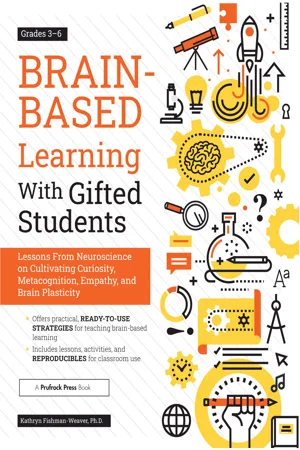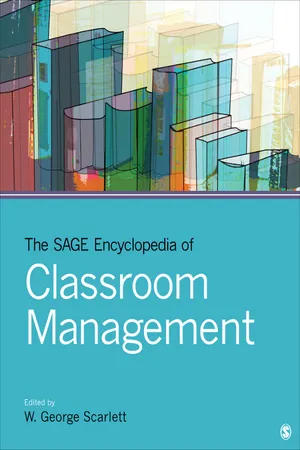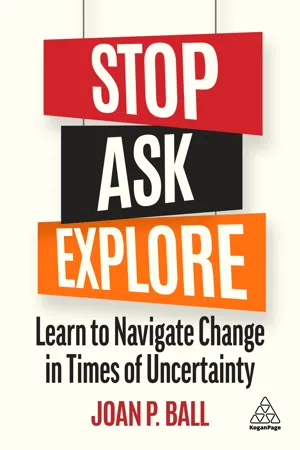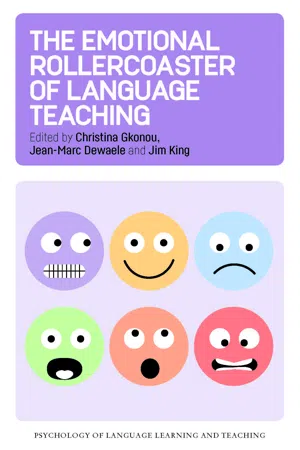Emotional Regulation
Emotional regulation refers to the ability to manage and control one's emotions in a constructive manner. In a business setting, emotional regulation is important for maintaining professionalism, managing stress, and fostering positive relationships with colleagues and clients. It involves recognizing and understanding one's emotions, as well as employing strategies to regulate and express them appropriately.
7 Key excerpts on "Emotional Regulation"
- eBook - ePub
Adaptable Interventions for Counseling Concerns
A Step-by-Step Clinical Workbook
- Freeman Woolnough, Autumn Marie Chilcote(Authors)
- 2017(Publication Date)
- Routledge(Publisher)
...3 Emotional Regulation ▶ What are Emotional Regulation Concerns? Our internal, intuitive, and sometimes instinctive response to our circumstances results in a range of sentiments, defining our emotional experience. This experience can inform our judgments, perceptions, and actions. Often the antecedents and intersection between emotion, behavior, and logical processing is very complex and difficult to define. Emotions work toward influencing our behavior, preparing the body for action via the release of neurochemicals. For example, dopa-mine release is associated with aggression and risk-taking, while oxytocin release is associated with attachment and soothing (Deans, 2011; Graham, 2013). While our bodies are readied for action through this physiological response, our ability to regulate the emotional response determines the resulting behaviors. When Emotional Regulation becomes a concern for clients, you may hear this or other phrases explored in this chapter while in session: “I couldn’t control myself; it’s not like me to act that way.” As noted above, emotions influence our thoughts and behaviors. Often this is helpful, such as the urge to offer sympathy when a person is upset, or applauding in appreciation. When an unexpected emotion arises, such as surprise or fear, sometimes the behavioral response precludes full consideration of the appropriateness of the response. This is not always disruptive. For instance, consider a mother crying after seeing that her children had cleaned the house while she was at work. Feeling surprise, joy, and appreciation resulted in her immediate but unusual (for her) response of crying. The fullness of her emotions caused her to respond behaviorally before she was able to consider a range of responses that may have appeared more appropriate...
- (Author)
- 2020(Publication Date)
- Wiley(Publisher)
...According to this model, a person facing an unpleasant work environment might change jobs or transfer to another department (situation selection), redecorate the office to make being at work pleasant (situation modification), intentionally ignore problematic co‐workers (attentional deployment), reframe a boss’s criticism as feedback that will help a career trajectory in the long‐term (cognitive change), or practice relaxation and deep‐breathing techniques to facilitate relaxation when becoming annoyed by co‐workers (response modulation). While most of these examples involve a person using emotion regulation strategies to increase positive emotions and decrease negative emotions, emotion regulation may also be used to increase negative emotions (e.g., helping an assault victim become angry with his/her attacker rather than engaging in self‐blame) or to decrease positive emotions (e.g., suppressing a case of the “giggles” when situationally inappropriate) (Gross, 2015). Development of Emotion Regulation Emotion regulation is typically understood as a fairly stable trait, which emerges in childhood. The bulk of the development of emotion regulation appears to occur in the first few years of life. Individual patterns of emotion regulation emerge and stabilize by age two, with minimal changes in the years that follow (Eisenberg, Spinrad, & Eggum, 2010). Early antecedents of the ability to regulate emotion have been measured even in infancy, expressed as temperamental tendencies to express emotion and recover from distress. Rothbart (1981) was among the earliest researchers to quantify temperament in the first year of life. She defined infant temperament as individual differences on two dimensions – reactivity and self‐regulation...
- eBook - ePub
Training Teachers in Emotional Intelligence
A Transactional Model For Elementary Education
- Elena Savina, Caroline Fulton, Christina Beaton(Authors)
- 2021(Publication Date)
- Routledge(Publisher)
...Further, students are skilled in recognizing when adults are not being authentic. EMOTION REGULATION As you are learning from this book, all emotions are functional. However, when they become too intense and interfere with our activities, or they happen in the wrong context, we need to regulate them (Gross, 2015). Emotion regulation comprises the ability to accept one’s own emotions, engage with emotional experiences that are desired, and disengage with negative emotions (Mayer, Caruso, & Salovey, 2016). The regulation of negative emotions is important for teachers, as it can impact the overall emotional climate of the classroom. Poorly managed emotions distract teachers from teaching as they become preoccupied with their emotional distress (Garner, 2010). Good emotion regulation helps teachers provide high-quality instruction and facilitates effective classroom management. Seeing a calm teacher who is in control provides students with a sense of security and a positive model for emotion regulation. Teachers with good emotion regulation skills are more flexible in responding to emotionally charged situations in the classroom and can diffuse situations with dysregulated students (Farb, Anderson, Irving, & Segal, 2014). On the contrary, teachers who have difficulty regulating their emotions in a stressful situation may react too quickly, causing a relational rift between them and their students, thus leading to an increased stress level in the classroom. Additionally, unregulated negative emotions contribute to teacher burnout (Fiorilli, Albanese, Gabola, & Pepe, 2017). Our beliefs about emotions may significantly affect how we regulate them (Castella, Platow, Tamir, & Gross, 2018). Those who think that they have little control over their emotions and cannot change them tend to avoid their emotions and experience higher levels of distress. Think about your beliefs regarding emotions...
- eBook - ePub
Brain-Based Learning With Gifted Students
Lessons From Neuroscience on Cultivating Curiosity, Metacognition, Empathy, and Brain Plasticity: Grades 3-6
- Kathryn Fishman-Weaver(Author)
- 2021(Publication Date)
- Routledge(Publisher)
...Instead, emotions are information. Emotional Regulation helps students (and teachers) better understand and respond to their complex feelings. As people get older, they tend to become more adept at Emotional Regulation. One gifted student described it to me in this way: “It’s learning strategies to give me some control over my emotions rather than always feeling like my emotions are controlling me.” KEY CONCEPT Emotional Regulation: The process by which one recognizes, experiences, and responds to feelings. Explicit Emotional Regulation: A conscious effort to use strategies to respond to emotions. Implicit Emotional Regulation: Automatic processes in response to emotions. Emotions interact and influence each other (Okon-Singer et al., 2015). For example, when a person is deeply angry, they are less likely to experience joy. However, by recognizing, naming, and processing that anger, they may be able to both regulate it and create space for additional emotions such as joy. Likewise, when a person is persisting toward a goal, sometimes their feelings of pride or joy are enhanced by earlier experiences with frustration or sadness that occurred as they strove for this goal. Teachers can help students with strategies to improve their explicit Emotional Regulation skills. This starts with five basic premises shown in Figure 12. When it comes to emotion, neuroscience supports what teachers have long suspected: How students feel affects how they learn. Emotion and cognition are not separate processes. Instead, the complex interplay of emotional processing and cognitive processing reveals a coordinated response across brain structures with consequences for attention, working memory, and executive functioning (Okon-Singer et al., 2015). Neuroscientists are continuing to learn more about how and where emotion happens in the brain. The Neuroanatomy of Emotions: A Look at the Limbic System This unit focuses on key structures of the limbic system...
- eBook - ePub
- W. George Scarlett(Author)
- 2015(Publication Date)
- SAGE Publications, Inc(Publisher)
...Emotion Regulation Emotion Regulation James L. Floman James L. Floman Floman, James L. Miriam Miller Miriam Miller Miller, Miriam 303 305 Emotion Regulation James L. Floman Miriam Miller There are many pathways by which to promote effective classroom management. Emotion regulation, the ability to deliberately manage emotions of self and others to achieve a goal, is one potential pathway. This entry defines emotion regulation and considers emotion regulation strategies and programs as ways to support classroom management. Emotion Regulation: Definition and Strategy Types Emotion regulation is the ability to change or maintain the experience or expression of emotions to attain a goal—whether in oneself or in others. In the context of the classroom, emotion regulation occurs when students or teachers manage their own emotions, and when teachers help students to more effectively regulate their emotions in ways that improve their behavior and learning. Coping and self-control are terms sometimes used interchangeably with emotion regulation. However, coping is characteristically a response to long-term adverse events, whereas emotion regulation is a response to short-term positive and negative emotional events. Self-control is the ability to consciously inhibit an impulse, which may include emotions, but may also include management of cognition and behavior. Emotion regulation differs by goals—such as reducing or increasing emotions—and by strategies—such as going for a walk or talking to a friend. Given the diversity of emotion regulation strategies, psychologist James J...
- eBook - ePub
Stop, Ask, Explore
Learn to Navigate Change in Times of Uncertainty
- Joan P. Ball(Author)
- 2022(Publication Date)
- Kogan Page(Publisher)
...Appendix A Emotion regulation Emotion regulation is a rich and diverse field of research that continues to evolve as we learn more about the psychological, physiological, philosophical, and cultural aspects of emotions and how they affect our thoughts, behaviour and self-concept. The following books and articles provide a stepping-off point for deeper exploration. This is not intended to be a complete list of relevant sources on this topic. It is, however, a representative sample of the resources that have helped to shape my thinking in the current research. Books How Emotions are Made: The secret life of the brain, Lisa Feldman Barrett The Upside of Stress: Why stress is good for you, and how to get good at it, Kelly McGonigal, PhD Emotional Agility: Get unstuck, embrace change, and thrive in work and life, Susan David, PhD The Unapologetic Guide to Black Mental Health: Navigate an unequal system, learn tools for emotional wellness, and get the help you deserve, Rheeda Walker, PhD The Gift of Fear: Survival signals that protect us from violence, Gavin de Becker The Managed Heart: Commercialization of human feeling, Arlie Russell Hochschild Handbook of Positive Emotions, Michele M Tugade, Michelle N Shiota and Leslie D Kirby Handbook of Emotion Regulation, edited James J Gross Unstuck: Your guide to the seven-stage journey out of depression, James S Gordon, MD Relevant academic articles Aldao, A (2013) The future of emotion regulation research: Capturing context, Perspectives on Psychological Science, 8 (2) pp 155–72 Dewick, P, Hofstetter, JS and Schröder, P (2021) From panic to dispassionate rationality—Organizational responses in procurement after the initial COVID-19 pandemic peak, IEEE Engineering Management...
- eBook - ePub
- Christina Gkonou, Jean-Marc Dewaele, Jim King, Christina Gkonou, Jean-Marc Dewaele, Jim King(Authors)
- 2020(Publication Date)
- Multilingual Matters(Publisher)
...Larsen-Freeman & Cameron, 2008), this chapter reports on an exploratory project into the emotion regulation behaviour of EFL teachers based at a university in Japan. We demonstrate that experienced teachers skilfully regulate their emotions in diverse ways to achieve a range of goals relating to their perceived responsibilities, their pedagogy and their well-being, and argue that the efficacy of their behaviour must be interpreted in relation to the internal and surrounding contexts that shape it. Given the important mediating role that emotion regulation can play in promoting psychological health (see Gross & John, 2003; Haeussler, 2013), we give special attention to some of the ways that the participants use emotion regulation to manage their well-being. Emotion Regulation Emotion regulation is contingent upon goals, higher-order motivations of regulation behaviour, and Tamir (2016) suggests that such goals pertain not only to performance and social aims (instrumental goals), but also to an individual’s sense of self (epistemic goals), and their psychological health (hedonic goals). Research in general educational contexts shows that teachers apply emotion regulation in aid of each of these goals, including instrumental goals relating to classroom management (Hosotani & Imai-Matsumura, 2011; Sutton, 2004; Yin & Lee, 2012), epistemic goals relating to the perceived responsibilities of teaching (Hagenauer & Volet, 2014; Hosotani & Imai-Matsumura, 2011; Sutton, 2004; Yin & Lee, 2012) and hedonic goals relating to well-being (Haeussler, 2013)...






